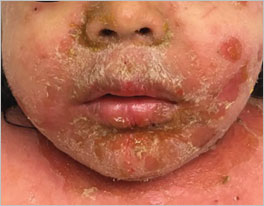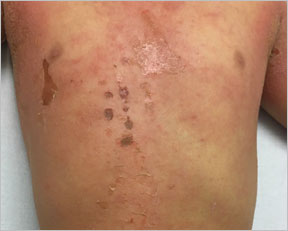4-year-old healthy female presents to ED with a rapidly worsening rash



Source: Marissa J. Perman

A 4-year-old healthy female presented to the ED with a rapidly worsening rash. Two days before, she had seen her primary care physician for bumps on her cheek, which were diagnosed as hand-foot-and-mouth disease, or HFMD. The patient developed more bumps on her face and body, with increasing pain and discomfort. On the morning of presentation, her eyes seemed slightly swollen, and her mother noticed the appearance of “water blisters” on her skin. This prompted her to bring the patient to the ED.
The patient was afebrile and drinking well, although she was not eating much. No topical products were applied to the skin. The only medication she received was two doses of ibuprofen for pain after the rash began. No one else at home had any rashes, although HFMD was going around her preschool class.
On exam, the patient was nontoxic but uncomfortable and lying still. She had broad areas of erythema over much of her body with accentuation in the skin folds. She had significant yellowish crusting with underlying erythema on her face, concentrated around the mouth and eyes (Figure 1). There were no intraoral, conjunctival or urethral lesions noted. Multiple crusted erosions were seen on the trunk. Examination of the axillae, groin and neck revealed flaccid vesicles with clear fluid and thin desquamation (Figure 2). A complete blood count and comprehensive metabolic panel were normal.
Can you spot the rash?
A. HFMD
B. Toxic epidemal necrolysis (TEN)
C. Toxic shock syndrome (TSS)
D. Staphylococcal scalded skin syndrome (SSSS)
E. Pemphigus foliaceus
Case Discussion
SSSS is a toxin-mediated process commonly seen in infants and young children (choice D). As the name implies, the condition is caused by infection with Staphylococcus aureus, which produces exfoliative toxin A and B. These toxins target desmoglein 1, causing a split in the stratum granulosum of the epidermis, and presence of the toxin in the bloodstream causes the diffuse rash typical of the condition. Peak incidence is between the ages of 2 and 3 years, and in patients aged older than 5 years, the condition is more common in immunocompromised individuals or patients with renal disease. Decreased renal clearance of toxin is hypothesized to be partially responsible for the presence of the disease in younger age groups.
The rash begins rapidly, often with the onset of sunburn-like erythema that is tender. This erythema rapidly gives way to flaccid, fluid-filled vesicles or bullae that easily rupture and form large erosions and areas of thin desquamation with the presence of Nikolsky’s sign. These skin findings are accentuated in the skin folds, including the neck, axillae and groin. Additionally, patients with SSSS have a classic appearance known as “sad man facies,” with significant periorbital and periocular erythema causing thick yellow-colored crusting. Although skin findings and edema may be impressive around the eyes, mouth and genitalia, the mucosal surfaces themselves are characteristically spared. The diagnosis is typically made on a clinical basis, and biopsy is not usually needed.
Sometimes SSSS may begin with a localized cutaneous staphylococcal infection, whereas other times it may be difficult to identify an initial bacterial source. Although exfoliative toxins travel hematogenously, blood cultures are typically negative for bacteria. Cultures taken from the areas of most prominent skin peeling, such as the axillae and groin, are typically negative because the rash in these areas is caused by bacterial toxin rather than the bacteria themselves. However, it is still important to obtain cultures of the responsible organism to guide antibiotic treatment. If an initial cutaneous source can be easily identified, culture of this area may reveal the culprit S. aureus strain. However, cultures can be obtained from areas most likely to harbor the bacteria in the absence of an obvious source, which includes the umbilicus and perioral and perianal areas.
Prompt antibiotic treatment is critical to prevent morbidity and mortality from this condition. Older children with very early or mild cases may be treated as outpatients, but most patients require initial therapy with IV antibiotics. Empiric therapy with an antistaphylococcal antibiotic such as nafcillin, oxacillin or cefazolin should be started as soon as possible. Some experts also recommend dual coverage with clindamycin or another antibiotic to halt toxin production, although this remains controversial. Pain management with systemic medications is also an important consideration for these patients. No topical emollients should be applied until the patient’s exquisite skin tenderness is improved. Patients with clinical improvement may be transitioned to oral antibiotics. Full resolution of skin peeling may take several weeks.
Bullous drug reactions, which include Stevens-Johnson syndrome (SJS) and TEN, should be considered in the differential of a widespread, painful, blistering rash. However, there is full-thickness epidermal necrosis in these conditions, and mucosal involvement is typically seen. Patients with SJS/TEN also have fever and may have “hidden” mucosal sites like the esophagus and lungs. Pemphigus foliaceous is a rare, autoimmune, blistering disorder with antibodies also targeting desmoglein 1, leading to superficial blisters. However, the bright erythema, tenderness and accentuations in folds are most consistent with SSSS.
TSS can also cause a red rash that is typically accentuated in the skin folds with peeling. However, the facial crusting seen in patients with SSSS is typically absent. Additionally, patients show signs of true septic shock, with high fevers, tachycardia and hypotension.
SSSS is a painful skin condition mediated by S. aureus exfoliative toxins, leading to widespread tender erythema and skin peeling. Cultures from areas of desquamation will be negative, but the causative organism can be identified by culturing common sites of S. aureus colonization. Patients should be started on antistaphylococcal antibiotics immediately.
- References:
- Eichenfield LF, et al. Neonatal and Infant Dermatology. 3rd ed. London: Elsevier; 2015.
- Leung AKC, et al. World J Pediatr. 2018;doi:10.1007/s12519-018-0150-x.
- Paller AS, et al. Hurwitz Clinical Pediatric Dermatology: A Textbook of Skin Disorders of Childhood and Adolescence. 5th ed. London: Elsevier; 2016.
- For more information:
- Colleen H. Cotton, MD, is a pediatric dermatology fellow at The Children’s Hospital of Philadelphia. She can be reached at CottonCH@email.chop.edu.
- Marissa J. Perman, MD, is an attending physician at The Children’s Hospital of Philadelphia.
Disclosures: Cotton and Perman report no relevant financial disclosures.
